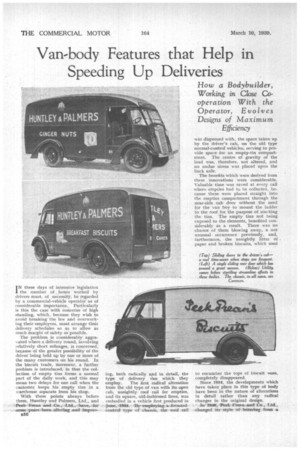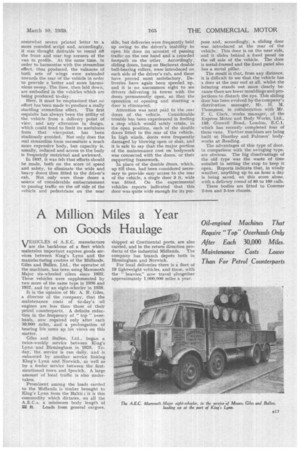Van-body Features that Help in Speeding Up Deliveries
Page 50

Page 51

If you've noticed an error in this article please click here to report it so we can fix it.
How a Bodybuilder, Working in Close Cooperation With the Operator, Evolves Designs of Maximum
Efficiency
Ithese days of intensive legislation the number of ..hours worked by drivers must, of necessity, be regarded by a commercial-vehicle operator as of considerable importance. Particularly is this the case with concerns Of high standing, which, because they wish to avoid breaking the law and Overworking their employees', muSt arrange their delivery schedules so as. to allow as much margin of safety as possible.
The problem is considerably aggravated where a delivery round, involving relatively short mileages, is concerned, because of the greater possibility of the driver being held up by one or more of the many customers on his round. In the biscuit trade, moreover, a further problem is introduced, in that the collection of empty tins forms a normal part of the daily work, and this may mean two delays for one call when the customer keeps his empty tins in a lvarehouse separate from his shop.
With these points always before them, -Huntley and Palmers,. Ltd., and Petek. Fan and rCe.., Lt4..,--.1tave,. for some years -13een.aig and Unprov
en lug, both radically and in detail, the type of delivery Van which they employ. The first radical alteration from the old type of van with its open cab, unsightly roof rail for empties, and its square, old-fashioned lines, was embodied in a vehicle first produced in
1934.I3y. employing a forwardcontrol type of chassis, the roof rail
was dispensed with, the space taken up by the driver's cab, on the old type normal-control vehicles, serving to provide space for an empty-tin compartment. The centre of gravity of the load was, therefore, not altered, and no undue stress was placed upon the back axle.
Thebenefits which were derived from these innovations were considerable. Valuable time was saved at every call where eropties had to be collected, because these wore placed straight into the empties compartment through the near-side cab door without the need for the van boy to mount the ladder to the roof for the purpose of stacking the tins. The empty tins not being exposed to the elements, benefited considerably as a result. There was no chance of them blowing away, a not unusual occurrence previously, and, furthermore, the unsightly litter of paper and broken biscuits, which used
to encumber the tops of biscuit vans, completely disappeared.
Since 1934, the developments which have taken place in this type of body have been in the nature of alterations in detail rather than any radical changes in the original design.
hi Mai' 3, -Peek Frean Aar/ Co_, f.td., elangecl its style of lettering from a
somewhat severe printed letter to a more rounded script and, accordingly, it was thought desirable to round off the front and rear top corners of the van in profile. At the same time, in order to harmonize with the streamline effect, thus produced, the valances of both sets of wings were extended towards the rear of the vehicle in order to provide a better and more harmonious sweep. The lines, then laid down, are embodied in the vehicles which are being produced to-day.
Here, it must be emphasized that no effort has been made to produce a really startling streamline effect. The first requisite has always been the utility of the vehicle from a delivery point of view, arid any alteration in design, which could tend to limit its usefulness from that viewpoint, has been studiously avoided. Not only does the real streamline form necessitate a much more expensive body, but capacity is, usually, reduced and access to the body is frequently restricted and awkward.
In 1937, it was felt that efforts should be made, both on the score of speed and safety, to eliminate the wide and heavy doors then fitted to the driver's cab. Not only were these doors a source of considerable embarrassment to passing traffic on the off side of the vehicle and pedestrians on the near side, but deliveries were frequently held up owing to the driver's inability to open his door on account of passing traffic on the one hand and a crowded footpath on the other. Accordingly, sliding doors, hung on Beclawat double ball-bearing rollers, were introduced on each side of the driver's cab, and these have proved most satisfactory. Deliveries have again been speeded up, and it is no uncommon sight to see drivers delivering in towns with the doors permanently open, so that the operation of opening and shutting a door is eliminated.
Attention was next paid to the rear doors of the vehicle. Considerable trouble has been experienced in finding a stop which would safely retain, in the open position, each of the double doors fitted to the rear of the vehicle. In high winds, doors were frequently damaged by blowing open or shut, and it is safe to say that the major portion of the maintenance cost on bodywork was connected with the doors, or their supporting framework.
In place of the double doors, which, up till then, had been considered necessary to provide easy access to the rear of the vehicle, a single door 3 ft. wide was fitted. On the experimental vehicles reports indicated that this door was quite wide enough for its pur
pose and, accordingly, a sliding door was introduced at the rear of the vehicle. This door is on the near side, and it slides behind a fixed panel on the off side of the vehicle. The door is metal-framed and the fixed panel also has a metal pillar.
The result is that, from any distance, it is difficult to see that the vehicle has a door at the rear end at all, whilst the lettering stands out more clearly because there are fewer mouldings and projections to disturb the eye. This sliding door has been evolved by the company's distribution manager, Mr. ff. M. Thompson, in collaboration with Mr, F. C. Clark, • works manager, of the Express Motor and Body Works, Ltd., 150, Goswell Road, London, E.C.1, which has recently completed four of these vans. Further machines are being built at Huntley and Palmers' bodyworks at Reading.
The advantages of this type of door, in comparison with the swinging type, arc obvious. The big disadvantage of the old type was the waste of time entailed in setting the stop to keep it open. Reports indicate that, in windy weather, anything up to an hour a day is being saved, on this score alone, with a delivery round of 80 to 100 calls.
These bodies are fitted to Comm& 2-ton and 3-ton chassis.




























































































